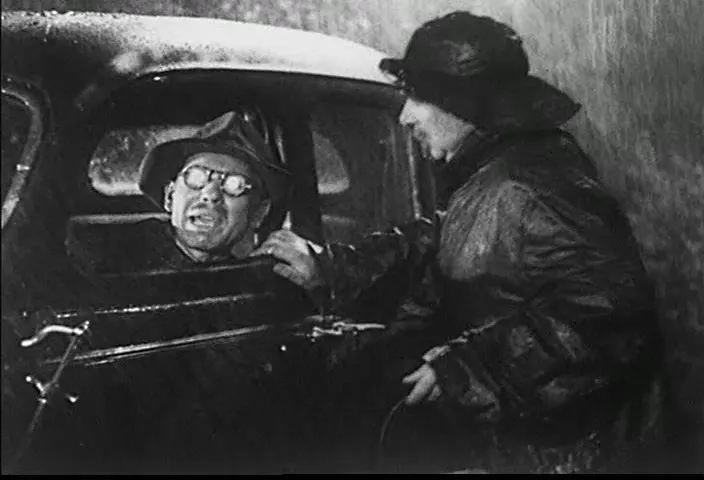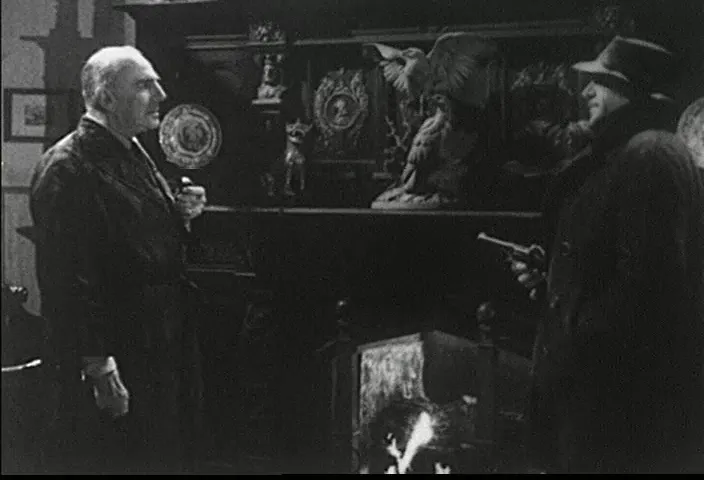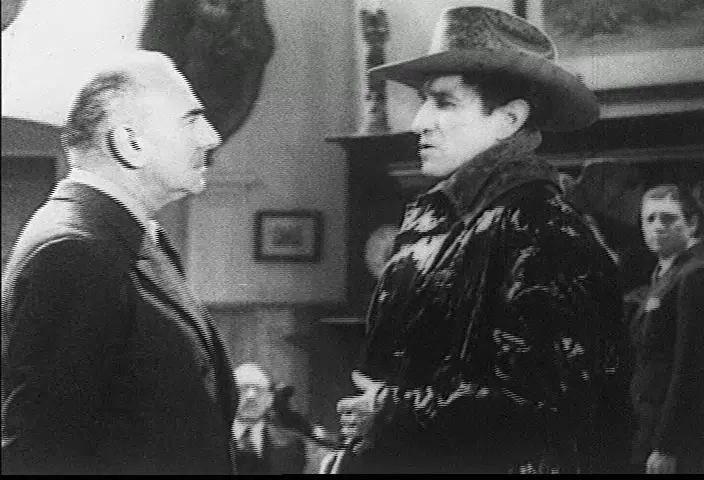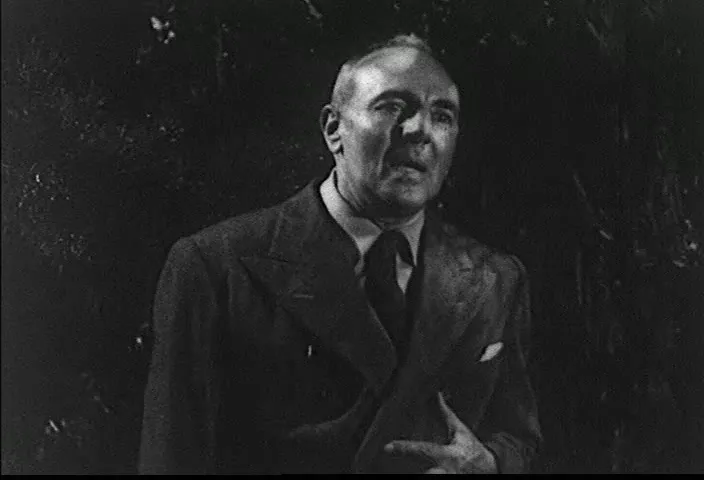Presented here as a focused appraisal of the 1943 Producers Releasing Corporation feature The Black Raven, this critique explores the film as a compact, atmospheric film noir movie and as a product of Poverty Row filmmaking. The analysis acknowledges Sam Newfield’s direction and situates the piece within the constraints and creative impulses of low-budget studio output, drawing from the on-screen narrative and the historical record preserved in contemporary references. The Black Raven emerges as an economical whodunit that borrows the visual and moral textures associated with a film noir movie while retaining an essentially pulp-mystery heart.
Outline
- Introduction: The Black Raven as a film noir movie and a Poverty Row artifact
- Production snapshot: Studio, director, cast, and running time
- Plot and structure: How the storm, the motel, and confined space drive the story
- Character study: Amos Bradford (The Raven), the eloping couple, the convict, and the sheriff
- Visual and thematic elements that evoke film noir movie sensibilities
- Screenplay, pacing, and the mechanics of the whodunit
- Performances and casting choices
- Reception and legacy: Contemporary assessments and later views
- Conclusion: What The Black Raven offers the noir-curious viewer
Introduction: A Poverty Row Film That Aspires to Film Noir Movie Resonances
The Black Raven is frequently cataloged as a 1943 American mystery film directed by Sam Newfield and released by Producers Releasing Corporation (PRC), one of Hollywood’s smaller studios of the era. Viewed through the lens of the classic noir canon, The Black Raven functions as a concise film noir movie in spirit more than in budgetary realization. It assembles the essential ingredients: a moral gray central figure, a claustrophobic setting, criminal schemes, and a rain-lashed night that traps characters together, forcing secrets into the open.
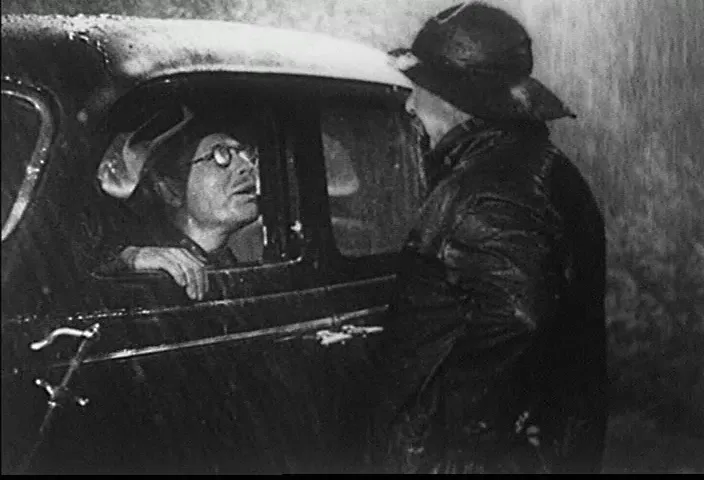
PRC’s limited resources—typical of Poverty Row—necessitated brisk shooting schedules and small crews, which often yielded films with a particular kind of narrative efficiency. In this instance, the efficiency enhances the film noir movie feel. Sam Newfield’s direction emphasizes containment and confrontation. The forced confinement at a single location, the Black Raven motel, becomes a pressure cooker where characters collide, motives are exposed, and violence tests loyalties.
Production Snapshot: Director, Studio, Cast, and Running Time
The Black Raven was directed by Sam Newfield and written by Fred Myton, with production credited to Sigmund Neufeld and cinematography by Robert E. Cline. The film’s running time is a brisk 61 minutes—meaning narrative economy is not a stylistic conceit but a production necessity. The cast, as recorded in period references, includes George Zucco as Amos Bradford (the Raven), Wanda McKay as Lee Winfield, Robert Livingston as Allen Bentley, Noel Madison as Mike Bardoni, Byron Foulger as Horace Weatherby, Charles B. Middleton as the sheriff, Robert Middlemass as Tim Winfield, Glenn Strange as Andy, and I. Stanford Jolley as Whitey Cole.
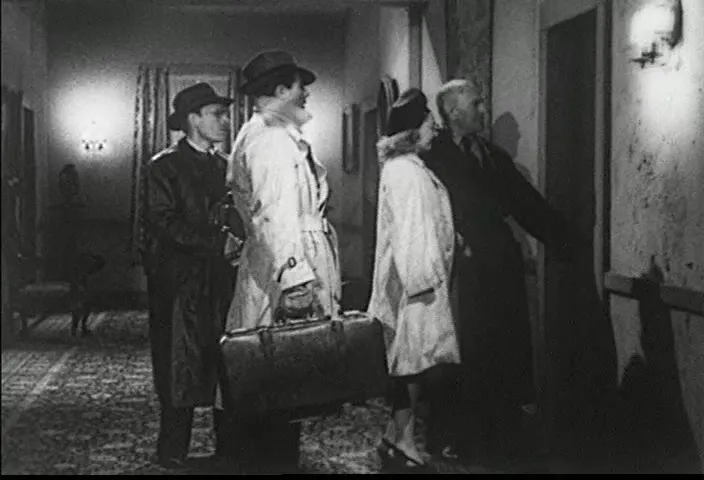
Released on May 21, 1943, and distributed by Producers Releasing Corporation, The Black Raven aligns with PRC’s strategy of producing marketable genre pictures—mysteries, westerns, and thrillers—on tight budgets. As a film chosen by PRC for release during wartime America, it exemplifies how smaller studios kept their output relevant by delivering condensed, consumable narratives that echoed larger studio melodramas and film noir movie tropes without the same budgetary polish.
Plot and Structure: A Storm, a Motel, and a Classic Locked-Room Whodunit
The film’s narrative opens in medias res with conflict already brewing between criminal partners, then quickly shifts to the forced sequestration at the Black Raven motel when a storm washes out the bridges. That washed-out-bridge motif is an economical but effective device: it strands disparate characters together in a single locale and gives the screenplay a clear mechanism to keep the ensemble under one roof. From a structural standpoint, this setup is a classic device for a film noir movie—a confined setting that amplifies tension and moral ambiguity.
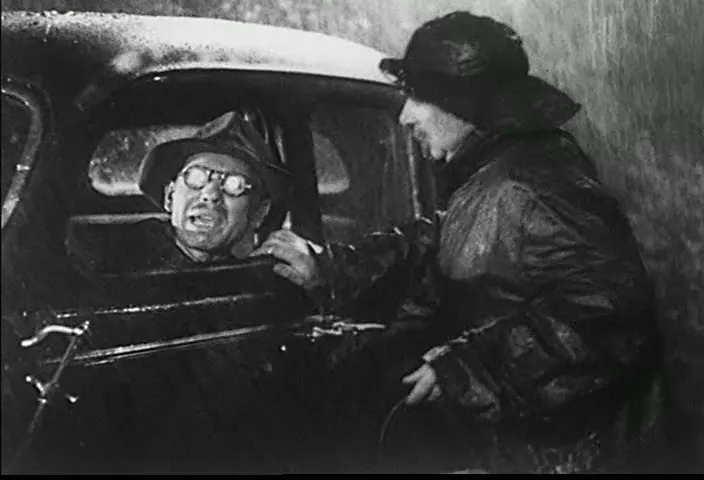
Converging at the motel are several archetypal figures: the motel proprietor with a shadowed past (Amos Bradford), an escaped convict (Whitey Cole) bent on revenge, a bank cashier who has embezzled a large sum (Horace Weatherby in transcript identity), a young eloping couple trying to outrun paternal control (Lee Winfield and Allen Bentley), and a domineering father (Tim Winfield) whose political clout fuels conflict. The sheriff provides a comic but earnest law-and-order presence. When murder occurs, the film pivots from character study to procedural mystery. The screenplay unfolds as the motel’s rooms and cellar are searched, alibis are probed, and motives are exposed.
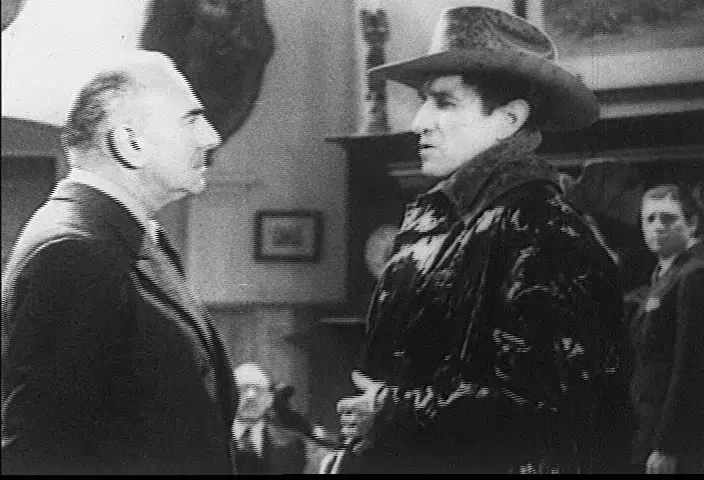
The Storm as a Narrative Engine
In noir-infused cinema, weather often functions as more than backdrop; it externalizes internal turbulence. The relentless rain and the decision of the characters to seek the Black Raven create a shared fate. Trapped together, they must reveal the choices that led them there. The storm justifies confinement and lends the film the moody atmosphere associated with a film noir movie: an oppressive night, intermittent electricity or dead phones, and the sense that escape is impossible.
Character Study: The Raven, the Lovers, the Convict, and the Comic Sheriff
Characterization in The Black Raven favors archetype—each player fills a familiar role within the mystery framework, but the film allows brief flashes of nuance that deepen these silhouettes. Examining the principal figures reveals how the film uses archetype to accelerate narrative recognition and viewer engagement, a common strategy for films made under tight time and resource constraints.
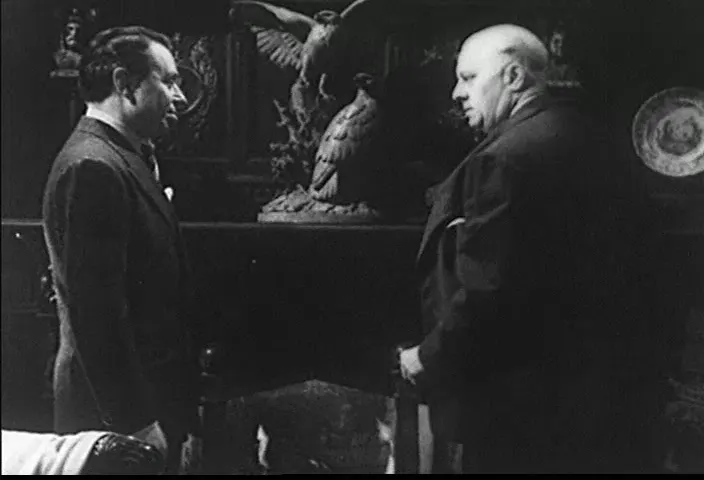
Amos Bradford — The Raven: A Morally Ambiguous Proprietor
Bradford is the central enigma. As proprietor of the Black Raven motel, he presides over the unfolding calamity with an interior strength that suggests both secret knowledge and a willingness to protect the innocent. He is not a saint; the screenplay implies a past of dubious associations. Yet Bradford’s choices—sacrificing himself in the film’s resolution—reveal a complexity consistent with film noir movie protagonists who operate within moral gray zones. His role is crucial: he functions as both suspect and moral arbiter, driving the mystery forward by testing other characters’ reactions.
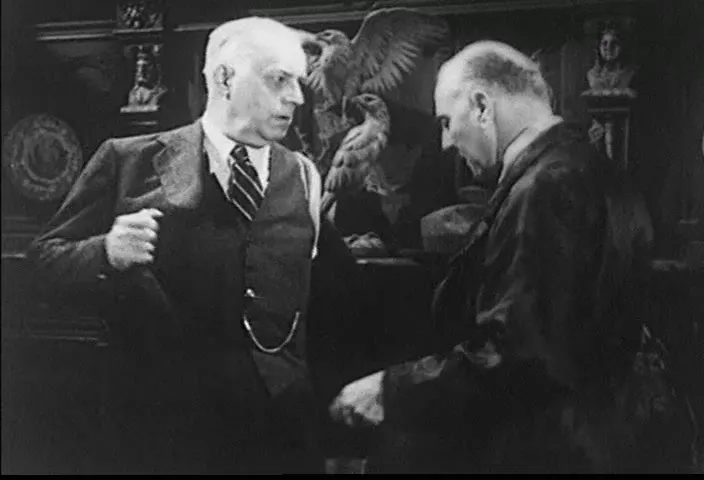
Lee Winfield and Allen Bentley — The Eloping Couple as Moral Center
The young couple provide the film’s emotional stake. They are straightforward: in love, defiant of a controlling patriarch, and minor players whose future is endangered by forces beyond them. Their elopement is the moral fulcrum that pulls other characters into the plot—particularly Tim Winfield, whose arrival escalates the situation to violence. In a film noir movie, young lovers often represent a possibility of redemption or a reason for a protagonist’s sacrifice; the Black Raven uses this dynamic to humanize Bradford and to justify the moral choices he makes.
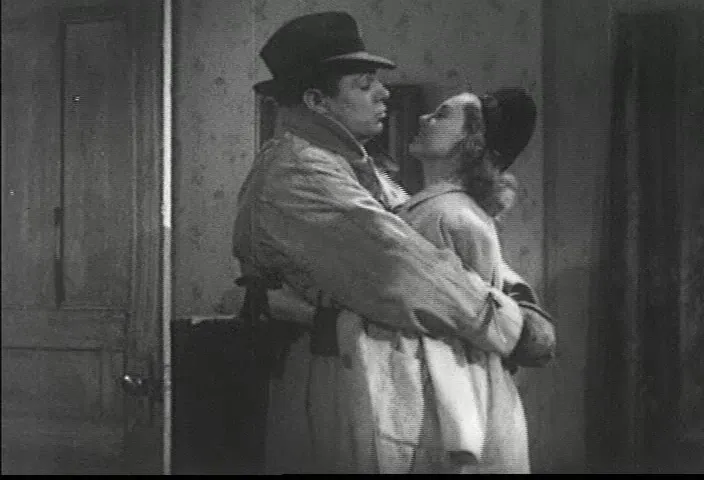
Horace Weatherby and Whitey Cole — Crime as Catalyst
Weatherby, the missing bank cashier in the transcript and the man with the satchel of money, introduces an explicitly financial motive into the story. Whitey Cole, the escaped convict who believes Bradford has double-crossed him, adds revenge as a motive. The presence of a substantial sum—fifty thousand dollars in the dialogue—turns interpersonal grudges into life-and-death stakes. For the film noir movie sensibility, money often functions as both temptation and ruin: characters reveal their moral defects when money changes hands or vanishes.
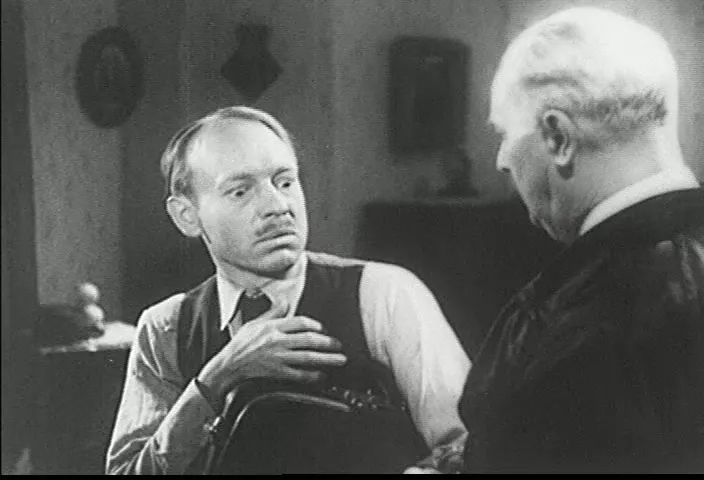
The Sheriff — Comic Relief with Consequences
The sheriff is written as an earnest but not particularly astute lawman, providing comic interludes that offset the film’s darker impulses. Yet even comic figures in noir and noir-adjacent films can cause trouble: clumsy investigations, misreadings of evidence, and bureaucratic force can all compound the tragedy. The Black Raven balances the sheriff’s bumbling with genuine authority: he arrests, interrogates, and ultimately contributes to the film’s resolution—an outcome consistent with the world’s moral accounting.
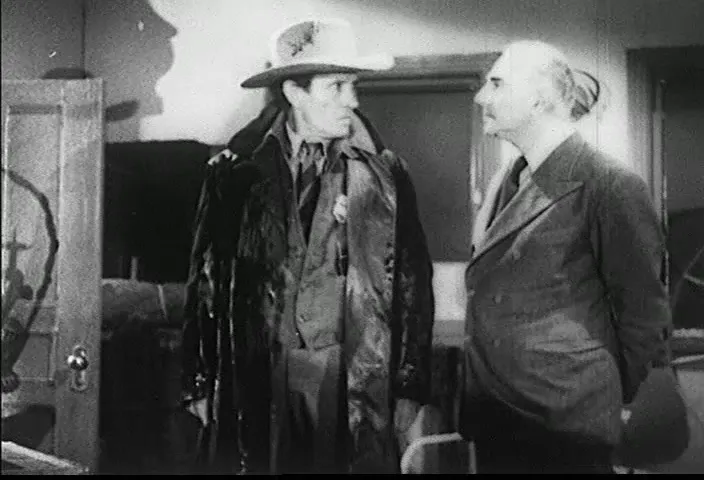
Visual and Thematic Elements That Evoke Film Noir Movie Sensibilities
The Black Raven embodies certain thematic motifs associated with film noir movie traditions: moral ambiguity, entrapment, blurred lines between respectable society and criminal enterprise, and the presence of a storm-darkened, shadowy environment. Although the film’s modest cinematography cannot fully replicate the high-contrast chiaroscuro of the best noirs, the limited setting and directed lighting create pockets of shadow and suspicion that serve the genre’s goals.
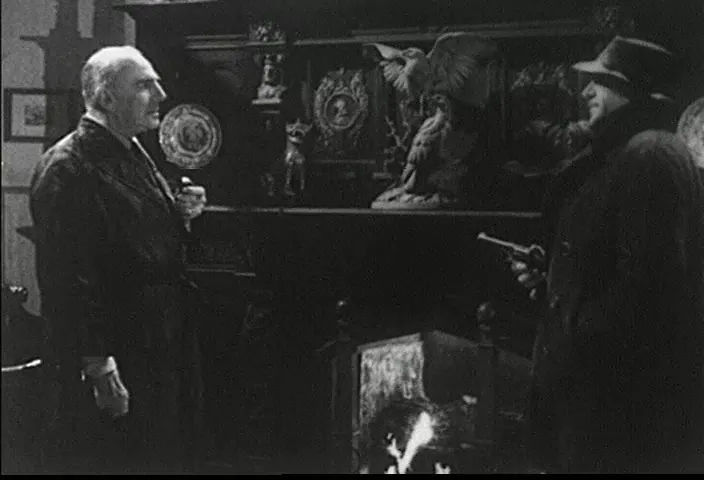
Atmosphere Over Glamour
Part of what makes The Black Raven feel like a film noir movie is its attention to atmosphere rather than to grand visual opulence. In a sixty-one-minute runtime, the camera uses corridors, doors, stairs, and rooms to build a visual vocabulary of confinement. The motel’s cellar and boarded windows, the dead telephone, and the washed-out bridge are objects that stand in for fate. They remind the viewer that choices are constrained and that chance plays a role in the characters’ downfall—an idea central to film noir movie thinking.
Shadows, Lighting, and the Sense of Immediacy
Robert E. Cline’s cinematography, while not lavish, emphasizes frames where characters are partly obscured or revealed by sudden flashes of light—gun flashes, lightning—heightening tension. This tactic is economical but effective: the film noir movie aesthetic relies on visual suggestion as much as on explicit exposition, allowing shadows and half-seen gestures to convey inner menace.
Screenplay, Pacing, and the Mechanics of the Whodunit
Fred Myton’s screenplay is an exercise in rapid plotting. The Black Raven compresses exposition and denouement into a short running time, yet it succeeds in laying out multiple motives and red herrings. The script uses repetition—accusations, retracted claims, searches for the satchel—to produce a rhythm that escalates the stakes. For a film noir movie, pacing often translates to mounting pressure rather than sublime meditations; here, the pressure cooker structure leads to a swift but plausible revelation.
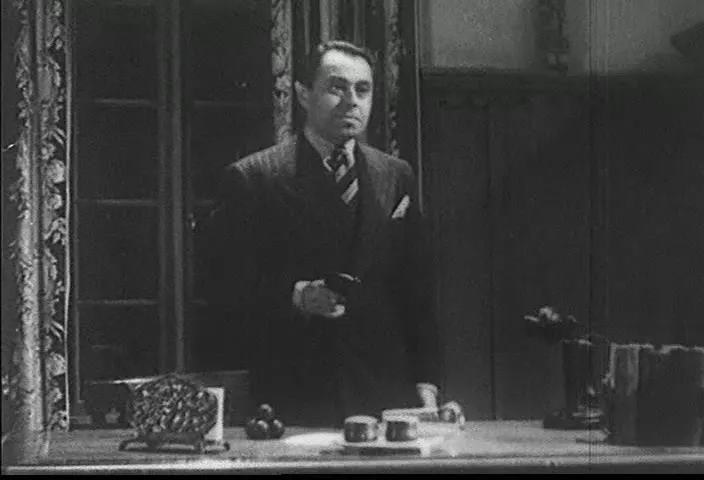
Red Herrings and Reveals
The film deploys red herrings effectively: Bradford’s ambiguous past makes him a reasonable suspect; the escaped convict’s presence supports the fear of external threat; the embezzled money gives almost everyone a motive. The screenplay arranges these elements so that viewers familiar with mystery conventions can anticipate shifts even as the film preserves the surprise of the final confession. That resolution—an uneasy, sacrificial reveal—uses character rather than mere plot trickery to satisfy narrative logic, a choice that aligns with the emotional realism often found in film noir movie outcomes.
Dialogue as Functional Economy
The dialogue keeps exposition concise; characters state motives, threats, and consequences with clarity. Repetitive lines—accusations and denials—serve a structural purpose: they anchor successive interrogations and investigations, reminding viewers of the stakes and of how quickly truth can be obfuscated in a crowded moral field. For a film noir movie, such verbal economy is crucial: long monologues are luxury; short, loaded phrases will do.
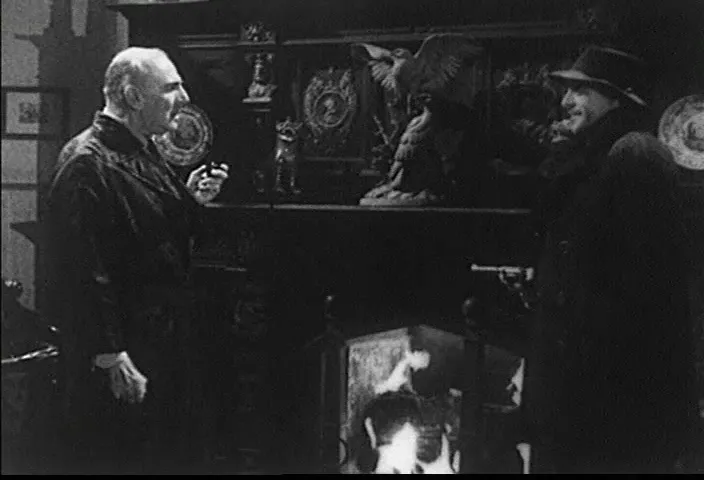
Performances and Casting Choices
George Zucco as Amos Bradford brings a gravitas that anchors the film. Zucco’s stage-honed mannerisms and measured vocal presence turn Bradford from a mere suspect into a figure with dignity and hidden complexity. Wanda McKay and Robert Livingston supply the emotional bedrock as the youthful lovers: their performances do not demand subtlety so much as sincerity, and the film benefits from the clarity of their intentions.
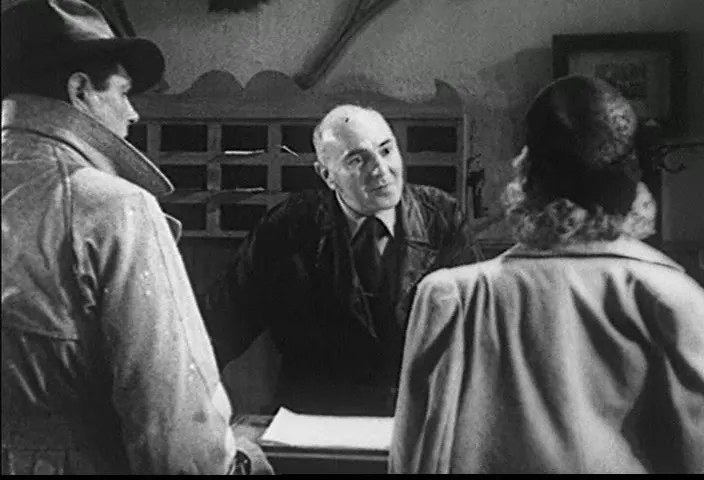
Noel Madison as Mike Bardoni and I. Stanford Jolley as Whitey Cole contribute necessary menace; they are efficient in channels where intimidation replaces long character arcs. Byron Foulger’s portrayal of Horace Weatherby gives the embezzler a vulnerable, world-weary quality—an archetype of the desperate man with one last chance to escape the machine of clerical routine. And Charles B. Middleton’s sheriff mixes comic and procedural elements, providing a foil to the more serious players while remaining a credible lawman.
Reception and Legacy: Contemporary Assessment and Later Views
Contemporary critical consensus for The Black Raven was mixed, acknowledging the film’s limited ambitions and noting its efficient but obvious plotting. Leonard Maltin, for example, regarded the film as a "paltry (and obvious) whodunit," awarding it one and a half out of four stars. That verdict underscores how the film registers less as a landmark film noir movie and more as a compact genre exercise. Yet the film’s economy of means and clear demonstration of noir-adjacent thematic concerns make it a useful study piece for enthusiasts of vintage mystery cinema.
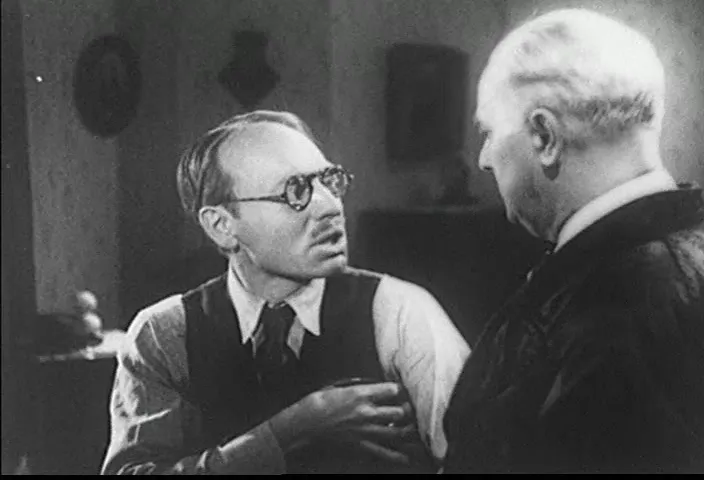
PRC’s place on Poverty Row ensured that The Black Raven would not occupy a large place in film history, but it provides a robust snapshot of how low-budget studios translated popular genre motifs into consumable pictures. The film remains available in public archives and is often cited as an example of effective storytelling under constraint. For those exploring the boundaries between B-movie mystery and classic noir aesthetics, it offers a concise case study.
The Black Raven as a Film Noir Movie — Strengths and Limitations
As a film noir movie, The Black Raven is notable for its adherence to a limited number of noir conventions rather than for wholesale adoption. It gravitates toward noir through moral ambiguity, night-bound action, and a sense that past sins reverberate into present danger. Its limitations—budgetary restrictions, cursory character development, and an obvious plot twist to more discerning viewers—do not necessarily diminish its historical or entertainment value. Instead, they frame the film as a working example of how noirish themes were absorbed by mainstream mystery filmmaking outside the major studio system.
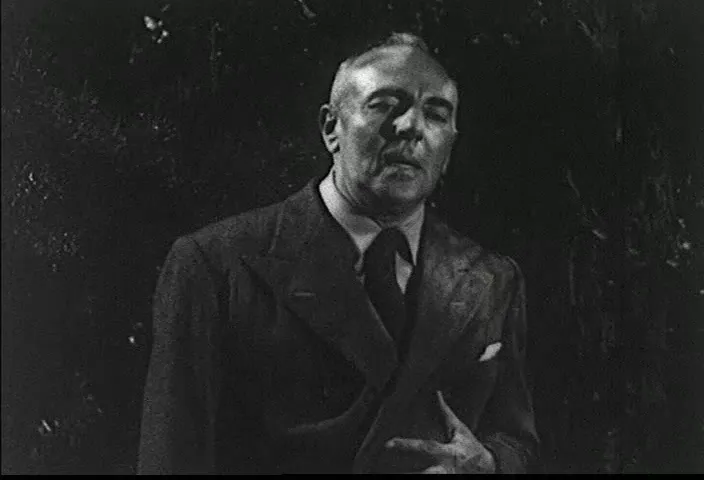
Strengths
- Economical plotting that sustains suspense across a compact runtime.
- Strong central performance from George Zucco that gives moral weight to the denouement.
- Effective use of a single location to generate escalating tension—the quintessential film noir movie claustrophobia.
- Clear, functional cinematography and lighting that suggest noir atmospherics within budget limits.
Limitations
- Lack of the visual opulence and stylistic refinement typical of top-tier film noir movie exemplars.
- Certain characters are schematic rather than fully realized, a trade-off of the short running time.
- Predictability in the mystery’s mechanics for viewers familiar with genre conventions.
Scene Anatomy: Four Key Moments That Define the Film Noir Movie Mood
Breaking down discrete scenes clarifies how The Black Raven constructs its noir-tinged mood in microcosm. The following moments illustrate the film’s mechanics and thematic interests.
- The Washed-Out Bridge and Arrival at the Black Raven
Function: Forces ensemble confinement and initiates the plot.
Mood: Isolation and inescapability, staples of the film noir movie atmosphere.

- Confrontation Between Criminal Partners
Function: Exposes past betrayals and provides an immediate motive for violence.
Mood: Taut and personal—noir’s sense of betrayal and retribution becomes tangible.

- The Sheriff’s Discovery and the Arrest
Function: Introduces official pressure and moves the narrative into procedural territory.
Mood: Law vs. chaos; the film noir movie often stages the law’s arrival as both relief and complication.

- The Confession and Sacrifice
Function: Resolves the whodunit and provides a morally complex ending.
Mood: Tragic resignation, a hallmark of film noir movie endings where redemption often requires loss.

Why The Black Raven Matters to Students of Film Noir Movie History
For students and enthusiasts of film history, The Black Raven offers several instructive lessons. First, it shows how noirish elements percolated through the industry beyond the major studios, informing small- budget mysteries. Second, the film demonstrates how tight storytelling and character compression can still evoke complex moral atmospheres. Finally, it provides an example of how the conventions of noir—entrapment, moral ambiguity, fatalism—can be adapted to fit economical production models without losing their thematic resonance.
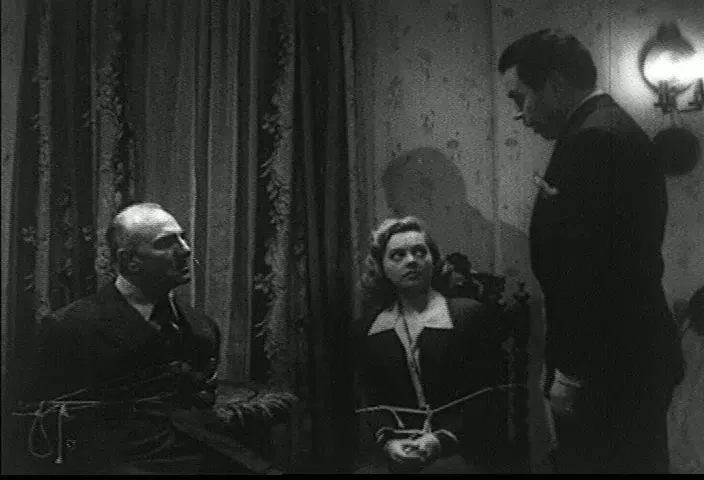
Appreciating The Black Raven requires adjusting expectations: it is not a defining film noir movie of the 1940s, but it is a telling artifact of how noir’s sensibilities were disseminated and adapted. Where more celebrated noir pictures luxuriate in stylistic excess, this film proves that the noir ethos—darkness, desperation, and a fateful night—can be convincingly conveyed with fewer means.
Concluding Assessment: A Compact Film Noir Movie Worth Revisiting
The Black Raven stands as a compact film whose strengths lie in its narrative economy, character-driven moral dilemmas, and atmospheric confinement. While it does not rise to the canonical heights of the most influential film noir movie titles, it provides a concentrated experience of noir-adjacent themes and produces a satisfying whodunit within the constraints of a sixty-one-minute runtime. The film’s final sacrifice—Bradford’s act to protect the young lovers—embeds it with a moral complexity that rewards viewers willing to look beyond surface-level plotting.
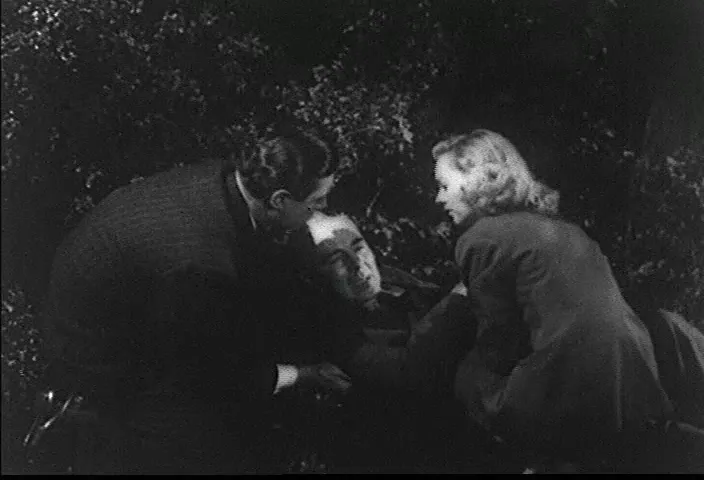
For historians of classic cinema, The Black Raven is valuable as a Poverty Row production that absorbed noir motifs into a practical genre format. For noir enthusiasts, it represents a modest but coherent exercise in the mood and structure that defined many films of the period: rain, money, betrayal, and an ending where justice arrives at the cost of sacrifice. In short, The Black Raven is a film noir movie by temperament if not always by the technical brilliance of larger-studio counterparts, and it rewards viewing as a tight example of wartime-era B-movie mystery craft.
Suggested Viewing Context
- Watch The Black Raven as part of a study of Poverty Row’s contributions to noir aesthetics.
- Pair it with a major-studio noir to compare resource-driven stylistic choices.
- Consider the film as an example of how narrative necessity can yield thematic clarity in a film noir movie context.
Final Note on Legacy
While The Black Raven was described by some critics as an obvious whodunit, its compact nature preserves a clear sense of noir ancestry. As such, it remains instructive: a snapshot of how crime, chance, and character were economically assembled into a film noir movie package for audiences of the early 1940s. For the cineaste invested in tracing the diffusion of noir themes across all levels of the studio system, revisiting The Black Raven offers both context and pleasure.

